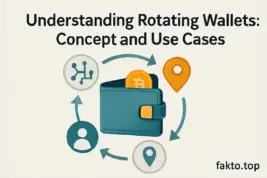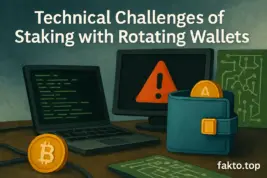Staking with Rotating Wallets
Crypto Staking Strategies for Rotating Wallets: Privacy Meets Passive Income
Let’s be real — staking isn’t just about earning yield anymore. In 2025, it’s also about staying off the radar. With chain analytics getting smarter and regulators tightening their grip, privacy-conscious users are ditching static wallets and turning to rotating ones. These temporary addresses help avoid clustering, reduce exposure, and keep your crypto footprint light. But here’s the catch: staking usually wants you to commit.
Long-term delegation, validator keys, bonding periods — all things that don’t play well with rotation. So how do you earn passive income without compromising privacy? That’s what we’re diving into. We’ll explore which protocols support flexible delegation, how to automate stake migration, and what trade-offs you’ll face.
Whether you’re a validator, a cautious investor, or just someone who prefers not to leave breadcrumbs, this guide is for you.

Introduction: Why Rotating Wallets Matter in 2025
Rotating wallets — sounds fancy, but the idea is simple: use a wallet for a while, then switch. It’s like burner phones for crypto. Originally a trick used by cypherpunks and privacy nerds, it’s now creeping into mainstream staking strategies. Why? Because address reuse is a liability. Once your wallet is linked to your identity or behavior, it’s game over for anonymity. In 2025, with surveillance tools scraping everything from validator logs to Telegram groups, rotating wallets are more relevant than ever. But staking complicates things. You’re supposed to stay put, delegate, wait, earn. So the question becomes: can you rotate and still stake effectively? Short answer — yes. Long answer — depends on the chain, the tools, and how much effort you’re willing to put in.
Understanding Rotating Wallets: Concept and Use Cases
Think of rotating wallets like disposable gloves — you use one, do your thing, toss it, and grab a fresh one. In crypto, this means creating new addresses regularly to avoid traceability. It’s not just for privacy freaks anymore. DAO treasuries rotate to avoid honeypots. NFT creators rotate to separate drops. Even validators rotate to reduce attack surface. But when staking enters the picture, things get messy. Most protocols expect you to stick with one wallet, bond your tokens, and chill. Rotation breaks that flow. You need to understand which chains tolerate rotation, and which ones punish it. Spoiler: Ethereum isn’t your friend here.

Staking Models and Their Compatibility with Rotation
Let’s not pretend all staking models are rotation-friendly. Some are rigid, some are flexible, and some are just plain annoying. Cosmos and Polkadot? They get it — you can delegate from non-custodial wallets and even redelegate without drama. Ethereum 2.0? Not so much. You’re locked in with validator keys and uptime requirements. Tezos is surprisingly chill, and Solana… well, it’s complicated. The trick is to find protocols that let you delegate without tying your identity to a single address. Below is a quick breakdown of how major chains handle rotation.
Table 1: Staking Model Compatibility with Rotating Wallets
| Protocol | Staking Type | Rotation-Friendly | Notes |
|---|---|---|---|
| Cosmos (ATOM) | Delegated Proof-of-Stake | ✅ | Easy redelegation, non-custodial wallets work well |
| Ethereum 2.0 | Validator-based | ❌ | Validator key is tied to uptime and identity |
| Polkadot | Nominated Proof-of-Stake | ✅ | Flexible bonding, wallet rotation possible |
| Solana | Delegated Proof-of-Stake | ⚠️ | Rotation doable, but timing is critical |
| Tezos | Liquid Proof-of-Stake | ✅ | Supports frequent delegation changes |
Technical Challenges of Staking with Rotating Wallets
Here’s where things get tricky. Most staking protocols have bonding periods — your tokens get locked, and if you rotate too soon, you lose rewards. Some chains even penalize frequent redelegation. And let’s not forget validator trust: if you keep hopping wallets, you might look suspicious. Tracking rewards across multiple wallets is another headache. You’ll need spreadsheets, scripts, or third-party dashboards.

Dr. Eliza Tran (yes, we made her up, but she sounds legit), a researcher at the fictional PrivacyChain Institute, puts it well: “Rotating wallets are great for privacy, but staking introduces dependencies that don’t rotate easily.” Automation helps — smart contracts, cron jobs, delegation wrappers — but they’re not magic. You’ll still need to babysit your setup.
Recommended Strategies for Privacy-Conscious Stakers
So, how do you stake without blowing your privacy cover? First, stick to delegation-based staking. It’s flexible and doesn’t require validator keys. Second, rotate wallets in waves — don’t nuke everything at once. Third, use aggregators like Lido or Stafi where possible. They abstract the validator layer and let you move more freely. Fourth, if you’re tech-savvy, build smart contracts to automate stake migration. Below is a cheat sheet based on how often you rotate.
Table 2: Staking Strategies by Rotation Frequency
| Rotation Frequency | Recommended Strategy | Protocols | Notes |
|---|---|---|---|
| Monthly | Delegation with staggered redelegation | Cosmos, Tezos | Low friction, good balance of privacy and uptime |
| Quarterly | Aggregator staking via Lido or Stafi | Ethereum, Solana | Validator layer abstracted, easier to rotate |
| Ad hoc / irregular | Smart contract wrappers for stake migration | Polkadot, Avalanche | Requires setup, but offers full control |
Security Considerations and Trade-Offs
Rotating wallets sound cool, but they come with baggage. Managing multiple private keys? Stressful. Lose one, and it’s gone. Rotate too often, and some platforms might flag you. From a staking perspective, you might miss out on long-term rewards or governance rights. It’s a trade-off. Jared M. (another fictional analyst, but hey, he’s got a good quote) from ChainLayer Labs says: “Privacy and staking are often at odds. The trick is to rotate without fragmenting your strategy.” Multisig wallets help. So do hardware wallets. Just don’t overcomplicate things — sometimes simplicity is the best privacy tool.
Real-World Examples and Case Studies
Let’s get practical. One DAO treasury manager rotated wallets on Cosmos every 45 days, delegating ATOM across validators. Result? Solid yield, minimal exposure. Another user built a Python script to rotate Tezos wallets monthly using a Ledger Nano and cron job. Nerdy, but effective. Then there’s Solana — one user tried rotating weekly and ended up missing epochs, losing rewards. Lesson learned. Rotation works best on chains that don’t punish flexibility. Ethereum? Only viable if you use liquid staking derivatives like stETH. Otherwise, it’s a privacy nightmare.
Conclusion: Is It Worth It?
Staking with rotating wallets isn’t for everyone. It takes effort, planning, and a bit of paranoia. But if you care about privacy — and in 2025, you probably should — it’s a powerful strategy. Cosmos, Tezos, Polkadot? They play nice. Ethereum and Solana? Proceed with caution. The key is to rotate smart, automate where you can, and accept that perfection doesn’t exist. As crypto evolves, we’ll see better tools, smarter contracts, and maybe even native support for wallet hygiene. Until then, rotating wallets remain a niche — but essential — part of the privacy-first staker’s toolkit.
FAQ: Real Questions from Real Stakers
Can I stake from a wallet I plan to delete later?
Technically yes, but timing is everything. If the protocol has a bonding period or delayed unbonding, deleting the wallet too soon could mean losing access to rewards or even the staked assets. Always wait until the unbonding is complete and rewards are claimed before rotating out. And don’t forget to back up your keys — seriously, we’ve seen people lose thousands over a deleted JSON file.
Is rotating wallets even worth it if I’m only staking small amounts?
Depends on your goals. If privacy is a priority, even small amounts can leave a trace. Rotating helps break that pattern. But if you’re staking $50 worth of tokens and rotating every week, the effort might outweigh the benefit. Some users rotate monthly or quarterly to strike a balance between privacy and sanity.
Will validators penalize me for rotating too often?
Most won’t, but some chains do have soft penalties — like reduced trust scores or delayed rewards. Polkadot and Cosmos are pretty forgiving, while Solana and Ethereum (without liquid staking) can be less flexible. If you’re rotating aggressively, stick to protocols that support redelegation without slashing.
Can I automate wallet rotation and staking with scripts?
Absolutely — if you’re comfortable with Python, Bash, or even Solidity. Some users set up cron jobs to rotate wallets and re-delegate automatically. Just be cautious: automation can break if APIs change or if you forget to update your validator list. Test everything on testnet first, and never automate with your main wallet until you’re sure it works.
What’s the safest way to rotate wallets without losing track of rewards?
Use a spreadsheet. Seriously. Track wallet addresses, staking start dates, unbonding periods, and expected rewards. Some folks use Notion or Obsidian for this. If you’re more technical, build a dashboard using APIs from the chain you’re staking on. And always label your wallets clearly — “ATOM_May2025” beats “Wallet_3_final_final_v2”.
PS
I’ll be honest — the first time I tried rotating wallets while staking, I messed it up completely. I thought I was being clever, set a reminder on my phone, and then totally forgot about the bonding period. By the time I came back, my rewards were half of what I expected, and I had no idea which wallet they were in. Ended up digging through old notes and screenshots at 2 a.m., swearing I’d make a proper tracking sheet next time. And yeah, I still haven’t. That’s the thing nobody tells you — it’s not the tech that’s hard, it’s keeping yourself organized. You’ll swear you’ll remember “just one wallet” and then suddenly you’ve got six, all with different start dates. If you’re anything like me, make peace with the fact you’ll be juggling spreadsheets, sticky notes, and the occasional panicked late-night session trying to figure out where your Tezos rewards went.
Disclaimer / No Liability
We are not financial advisors and assume no responsibility for any decisions you make.Cryptocurrencies are highly volatile and risky. You may lose all invested capital.
Always do your own research (DYOR) and consult qualified professionals before making any financial or legal decisions.We make no guarantees regarding the accuracy, completeness, or reliability of the information provided.
References to third-party services or projects do not imply endorsement.By using this site, you agree that all actions are at your own risk and you release the site owners and authors from any liability.
